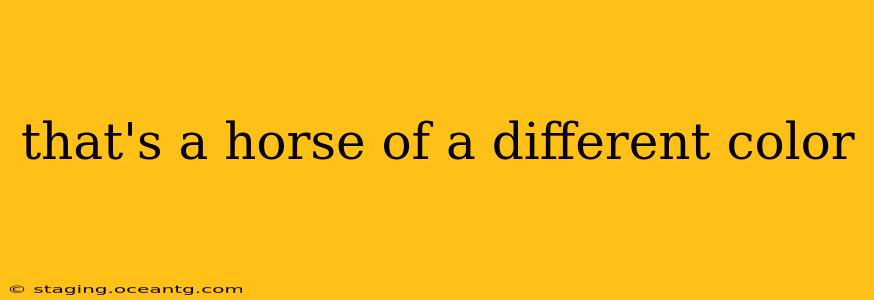That's a Horse of a Different Color: Understanding the Idiom's Meaning and Origins
The idiom "that's a horse of a different color" is a common way to express that something is significantly different from what was previously discussed or expected. It implies a complete change in circumstances, a shift in perspective, or a departure from the original topic. But where did this curious expression come from, and how can we best understand its nuances?
This seemingly odd phrase doesn't directly relate to horses in a literal sense. Instead, its colorful imagery paints a picture of distinction and contrast. Let's delve deeper into its meaning and historical background.
What Does "That's a Horse of a Different Color" Mean?
The idiom signifies a substantial difference, a complete change of subject, or a departure from what was initially being discussed. It highlights that a new situation or problem needs to be addressed separately, as it’s fundamentally distinct from the previous one. It's not simply a minor variation; it's a completely different beast altogether.
Think of it this way: you're discussing the merits of a particular car model, and someone suddenly shifts the conversation to the advantages of owning a boat. You might aptly respond, "That's a horse of a different color!"
Where Did This Idiom Originate?
While the exact origin is debated, the idiom's first known appearance in print is traced back to the early 17th century. Its usage gradually increased in popularity throughout the following centuries, solidifying its place in the English lexicon. The colorful imagery likely contributed to its enduring appeal and memorability. It's a phrase that evokes a visual, making it easier to remember and understand.
What's the Difference Between "That's a Horse of a Different Color" and Similar Phrases?
While many phrases convey a similar sentiment of difference, "that's a horse of a different color" possesses a unique flavor. Phrases like "that's a whole different story" or "that's another matter entirely" convey similar meanings, but lack the vivid imagery and slightly humorous tone that the horse idiom brings.
The "horse of a different color" expression emphasizes the complete distinction between two matters, suggesting an almost comical level of disparity. This nuanced difference in tone and emphasis makes it a particularly effective and memorable expression.
How Can I Use "That's a Horse of a Different Color" in a Sentence?
Using this idiom effectively requires understanding the context. It's best reserved for situations where a significant change in topic or circumstance is occurring. Here are a few examples:
- "We initially discussed budget cuts, but the sudden resignation of the CEO? That's a horse of a different color."
- "Yes, I can help you with the marketing plan, but fixing your broken computer? That's a horse of a different color."
- "I agree with your assessment of the current project, but introducing a completely new technology is a horse of a different color."
Is There Any Modern Usage of the Phrase?
Yes, absolutely! The idiom remains a vibrant part of modern English conversation, appearing in both informal and semi-formal settings. Its enduring popularity reflects its effectiveness in conveying a clear and memorable message. Its continued use proves it's more than just a quaint historical phrase; it's a versatile tool for communication that remains relevant today.
In conclusion, "that's a horse of a different color" is a wonderfully evocative idiom that efficiently communicates a significant change in subject or circumstance. Its enduring appeal comes from its unique blend of memorable imagery and effective communication. Understanding its origins and nuances will enhance your command of the English language and your ability to express yourself with greater precision and flair.
